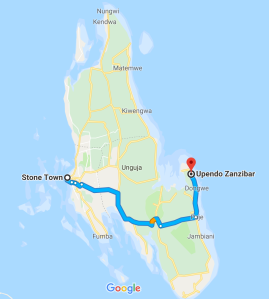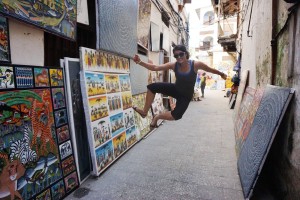February 2015
SLOWING DOWN IN STONE TOWN

On the ferry from Dar es Salaam to Zanzibar, for the first time in my life, I rode first-class. The air-conditioned boat deck was 100 per cent worth five extra bucks. It’s a breathtaking two-hour sail to Zanzi through the sapphire Indian Ocean, whose sparkling vista is sometimes broken up by a fishing boat or leisure craft. You can book tickets to and from the island at the Azam Marine office in Dar or Unguja. For more information, scroll to the Know Before You Go section at the bottom of this page.
I understand why Zanzibar is a bucket-list destination for many travellers; yet untouched by the hustle of urban living, it’s one of few tropical havens where you can swim with whale sharks, buy a bonafide Tanzanite at the source and immerse yourself in a unique intersection of Swahili, Arabic and Indian culture. Its historic centre, Stone Town, has no equal — an enchanting settlement of coral stone buildings, cobblestone streets and spectacularly carved wooden doorways.

I spent three days on Unguja, Zanzibar’s main island, after a week in Dar es Salaam in February 2015. Were it not for the humidity, it’s the kind of place I would have happily spent a month — reading, writing, experimenting with seafood, and getting lost in the old architecture and peaceful pace of life. Stone Town is an excellent place to eat, drink, watch the Premier League and enjoy living life a little more pole pole (slowly in Swahili). If you’re on a tight schedule, consider the itinerary below, but if you’ve got time, I’d recommend an expanded tour of this gorgeous archipelago that includes whale-watching, a visit to the spice and seaweed farms, a couple of white sand beaches and snorkelling.
Day One: On the Streets of Stone Town
If you’ve already got a visa for Tanzania, you don’t need one for Zanzibar too. Nevertheless, the entire archipelago is a semi-autonomous state, so you will need to line up at a port of entry to have your passport stamped and luggage inspected. We were in and out in under two hours (a pleasant surprise), and rolling our squeaky suitcases along the cobblestone streets of Stone Town in no time.

You will almost certainly be told by a cab driver in Unguja that everything worthwhile is too far away to be reached on foot. On the contrary, the Stone Town area is quite walkable, and within 15 minutes of rolling along the main road, we had reached the Africa House Hotel. We would be staying with at a friend’s flat, but were kindly allowed to leave our bags at reception until she finished her day at work.
To get to Stone Town from the port, make a right at the exit, follow the main road along the water, past the Old Fort and Forodhani Park, and go through the small tunnel at the end of the road that heads away from the water.
ART, ALLEYS AND ARCHES
We wasted no time in this vibrant UNESCO World Heritage Site. Stone Town is a beautiful maze of small alleyways lined with bicycles, bazaars, canvas paintings, baskets, boda bodas, drooping power lines, and chalk boards displaying the latest Premier League scores. It’s a delicious sensory experience, marked by the smells of chapati, paint, roasting fish and ocean breeze; and the sounds of distant ferry horns, the match on the TVs, and puttering motorbike engines.

The oldest part of Zanzibar City, Stone Town prospered as the centre of the spice and slave trades in the 19th century. The archipelago has been occupied by Bantu-speaking peoples for thousands of years, and it wasn’t until the early 16th century that its residents had any significant, lasting contact with Western or Middle Eastern traders. These cross sections are visible in its early 19th century verandas, wooden doors and baraza benches — a mix of traditional Indian, Arab, Persian, European and African designs.

I loved the Zanzibar doors most — finely carved masterpieces decorated with brass studs, pastel colours, columns and patterns, that stood out against the plain buildings they so often framed. I felt as though each door had a unique story; secrets acquired over centuries of comings and goings that could only be unravelled if I opened them. I imagine that such intriguing doors shield equally intriguing affairs within; if not now, then hundreds of years ago.

Shifting topics, Terhas and Basmah, whom I had travelled with from Tanzania to Zanzibar, agreed over cinnamon gelato (try the TAMU Gelateria!), that the shopping is much better in Zanzibar than in Dar es Salaam. If you’re coming from that direction, you may want to save your souvenir purchases for the island, whose shops hold a wider variety of trinkets, including hand-sewn dolls, coasters, and jua kali metal and textile work. We ended our day with delicious chapati wraps on the Stone Town Café patio (about TSh 12,000 per meal) in Shangani on Kenyatta Road. It’s just past the Old Post Office, and a wonderful place to people watch over an affordable meal.
Day Two: A Dark Glimpse into Zanzibar’s Past
We spent out second day strolling through more alleyways and historical sites of Stone Town. Our first stop was the Old Fort, which we had passed on Mizingani Road after exiting the port the day prior.
THE OLD FORT
The Old Fort is the oldest stone building in Zanzibar, built in the 17th century under the Sultanate of Oman when he seized the island from the Portuguese. At the time, the Omani controlled the archipelago, Kenya’s Mombasa and the entire Swahili coast. It was built to prevent attacks, but over the centuries, has also a prison and a tennis club.
Today, the fort is primarily used for its amphitheatre and cultural centre, where dances, workshops and musical performances are regularly held. It’s also got a row of knick knack vendors, in the event you can’t find what you’re looking for in the swath of craft shops tucked in Stone Town’s alleyways.
FORODHANI PARK AND THE HOUSE OF WONDERS
Adjacent to the Old Fort on Mizingani Road is one of Zanzibar’s most famous landmarks: the House of Wonders. The former sultan’s residence, built in 1883, it is said to have the largest doors in East Africa, and it was named the House of Wonders for its electricity and running water, which were new to Zanzibar. I wish we could have visited the museum inside, but it’s been closed for renovations since 2012. As of this blog’s posting date, the House of Wonders had not been reopened, but it’s worth a walk to the seafront to admire it from the outside.
Directly in front of the Old Fort and House of Wonders are the Forodhani Gardens, which are tranquil during the day, but turn into something else entirely at night. The gardens make up a gorgeous public park with ample shade, benches and an ocean view, and a few reasonably-priced cafés. It’s a lovely place to have a cold drink, watch the sail boats, the movement of the turquoise tide, and the daily commute from Zanzibar to Dar es Salaam. But don’t look for peace and quiet in the gardens at night, when they host a lively lamp-lit food market, whose vendors infuse the salty air with the smell of barbecued lobster, shrimp and other seafood delicacies, while musicians and trinket sellers stalk visitors for extra cash.
THE CHURCH AND THE SLAVE MARKET

From the gardens, we walked to what is undoubtedly the most disturbing, but important ‘attraction’ in Zanzibar: the island’s old slave quarters, found beneath St. Monica’s Lodge in the heart of Stone Town. Zanzibar was home to one of the world’s last open slave markets, presided over by Arab traders until its closure in the late 1800s. The former slave quarters — suffocating underground cellars without windows or toilets — are beneath the guesthouse, and open for public viewing at a cost of TSh 7,000. The tour is free if you stay at the guesthouse, although I couldn’t image sleeping above such a haunting site.

Our tour guide Christopher, who calls himself Zanzibar’s Morgan Freeman lookalike, escorted us into the depths of the prison, and attempted to lighten the mood by pointing out that the shackles dangling from the ceiling are actually snow chains from Canadian Tire. More than 100,000 people visit the old slave quarters each year, where it is estimated 15,500 slaves were imported from the mainland for sale to markets in Arabia, Persia, Egypt and other countries in the northern ports of the Indian Ocean.
Our tour wrapped up at the nearby Anglican Cathedral Church of Christ, whose altar is built upon the former site of the whipping post, where slaves were tortured to test them and determine their worth at an open auction.
SUNSET COCKTAILS
We ended our day on a lighter note, and that evening, Terhas, Basmah and I found ourselves at the Africa House Hotel once again. We weren’t there to collect luggage this time, but to watch the sunset over cocktails from the hotel balcony. The building really does have an unparalleled view of the ocean and evening beach activity, which it factors into the drink prices (about CAD 10 or TSh 17,000 each). Its beautiful white terrace stands above many Stone Town rooftops.
Once you’re done with mojitos and and Mai Tais, I recommend a walk down to the beach to watch Zanzibar’s famous informally-trained gymnasts, who often practice elite parkour and capoeira on the sand in the cool of dusk.
Day Three: Sand and Seafood
UPENDO BEACH
Feeling a little lazy after the high altitude cocktails, I spent my last full day in Zanzibar rolling around in sand and seashells at Upendo Beach, a beautiful stretch of white and blue along the Michamvi Peninsula. ‘Upendo’ means love in Swahili, and I dreamed of turquoise tides while on the cab ride there. It’s about an hour-and-a-half from the city by road, and crosses a good chunk of the Unguja. Our driver gave us a return trip for TSh 60,000.

It was nice to get out of Stone Town. Stone Town is a wonderful place, but its souvenir and gelato shops are removed from how most Zanzibaris really live. About half of the archipelago’s 1.3 million residents are below the poverty line on annual income of less than USD 250. We could see bits and pieces of it on our way to Upendo, as we drove past subsistence farms, struggling trade posts, and homes and schools in disrepair.

We felt privileged to be able to park ourselves at the Upendo Zanzibar, an upscale hotel and spa on the beach that lets visitors spend the day in its outdoor lounge with the purchase of a meal or drink. We chowed down on a delicious fruit, yogurt and granola brunch — the only guests on the patio that day — and watched the waves roll in and out. Terhas, Basmah and I also danced in the Indian Ocean, just to say that we did, collected sea shells, and chatted with Maasai craftsman selling their beadwork. We wondered what it would be like to eat at the famous seafood Rock Restaurant, literally on top of a rock in the ocean, visible from the hanging lounge chairs of Upendo Zanzibar. It was out of our price range. Maybe next time.
There are piles of spectacular beaches in Zanzibar, but Upendo is among the quieter ones. If you want a hassle-free place to relax, read a book and enjoy a mimosa, there’s nowhere better.
FORODHANI FOOD MARKET

When low tide rolled in, we made our way back to Stone Town. Our gracious host was having a party that night, and over Serengeti beers, we chatted football, work and all things East Africa. Like most Zanzibari parties, this one ended with a midnight snack at the world-renowned Forodhani Food Market, a seafront carnival that opens at dusk with dozens of chefs whipping up treats under the muted glow of table lanterns. I would be cautious around the seafood, which may or may not be fresh, but the Zanzibar pizza, made with egg, dough, cheese and veggies is always a local favourite. Each dish goes for between TSh 2,000 and TSh 8,000.
While the Forodhani Food Market is an evening hot spot, there’s lots to do in Stone Town at night. It’s a beautiful walk to begin with, its wooden doors illuminated by coloured lamps and string lights, and there’s always a party somewhere, whether it’s jazz night at 6 Degrees South or billards at Sweet Easy, both on Shangani Road. Bottoms up!
Day Four: The Journey Home

My mini-vacation had come to an end. Over 10 days, I had gone from Dar es Salaam’s largest newsroom, to an ankle-deep trash pile where I reported a public health story, to the lounge chairs of Upendo Beach in Zanzibar. It was time to return to Kenya, where I worked as a reporter for Nation Media Group in Nairobi.
I rode in economy on the way back to Dar, and peered out as the ferry whizzed past fishing boats and catamarans. I think Stone Town has the living thing figured – pole pole, a little more slowly. 
Know Before You Go
Travel Tips
- Book your ferry to and from Zanzibar through Azam Marine Co Ltd., which has economy fares for USD 35 and business class for USD 40. For the air conditioning and the view, shoot for business. The ferry has daily departures at 7 a.m., 9:30 a.m., 12:30 p.m. and 3:45 p.m. Don’t go without an advance reservation – the ferry is used for commuting to work, so every seat will fill up. Book at least a day or two ahead.
- Many cab drivers will tell you that hotels and attractions in Stone Town are far, but it’s a small place and we reached everything on foot with ease.
- If you don’t want to book a guided tour in Zanzibar, ask your hotel to recommend reliable cab drivers who can take you to the places you want to visit. Pay no more than TSh 60,000 for a cab to Upendo Beach.
- Check the times for low tide before heading to any beach in Zanzibar, or you’ll be disappointed when you get there to find that all the water is gone.
Where to Stay
- Zanzibar has a booming Airbnb scene, with most private bed and bathrooms going for USD 75 per night. Most accommodations offer WiFi, but prioritize the air conditioning!
- The Africa House Hotel has a fantastic location in central Stone Town and the best rooftop bar in town. Air-conditioned rooms with WiFi start at around USD 100. Make sure to ask for an ocean view. Reservations can be made via email at reservation@classichotelszanzibar.com.















